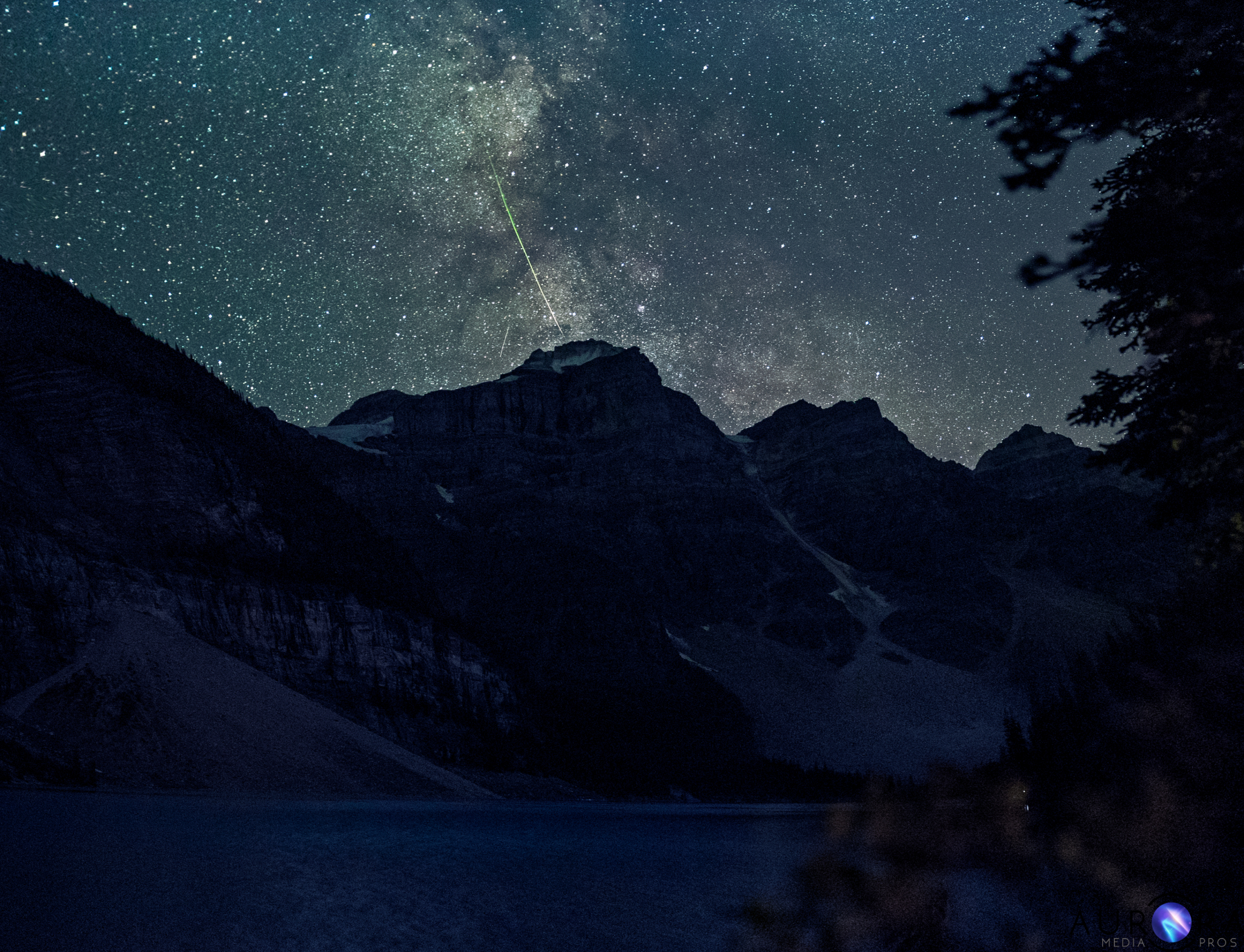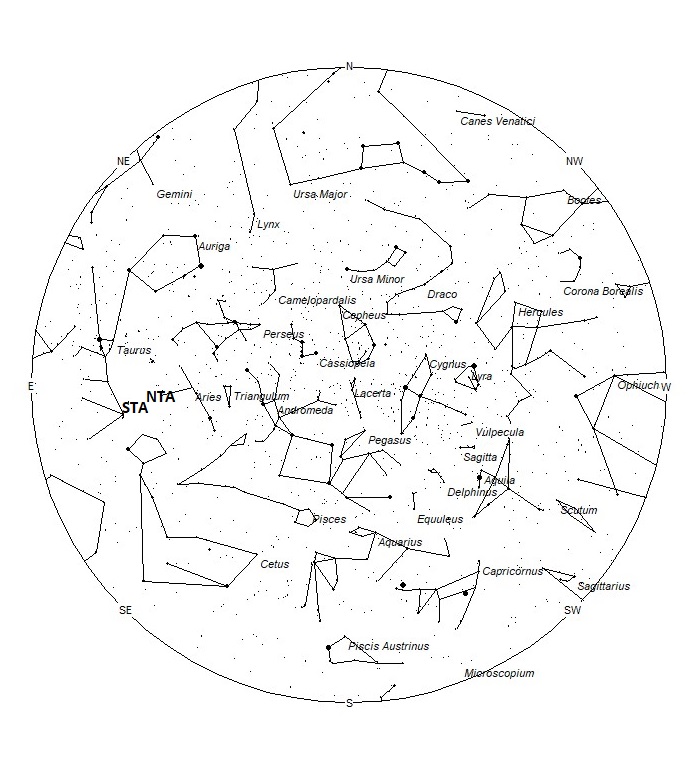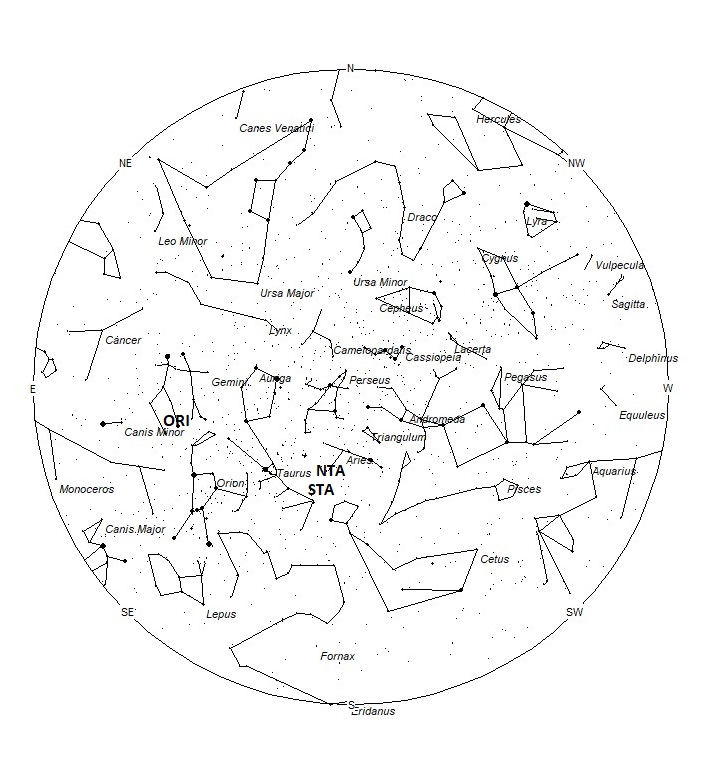 Christy Turner captured this bright meteor passing passing through a gorgeous star field at 23:10 MDT on 12 August 2021 (05:10UT 13 Aug.), from Moraine Lake, Alberta, Canada. ©Christy Turner
Christy Turner captured this bright meteor passing passing through a gorgeous star field at 23:10 MDT on 12 August 2021 (05:10UT 13 Aug.), from Moraine Lake, Alberta, Canada. ©Christy TurnerAs seen from the Northern Hemisphere, meteor rates continue to be strong in November. While no major activity is expected this month, the two Taurid radiants plus the Leonids keep the skies active. The addition of strong sporadic rates makes November one of the better months to view meteor activity from north of the equator. Skies are fairly quiet as seen from the Southern Hemisphere this month. Activity from the three showers mentioned above may be seen from south of the equator, but the sporadic rates are much lower than those seen north of the equator.
During this period, the moon reaches its new phase on Friday November 5th. At that time the moon lies near the sun in the sky and is invisible at night. This weekend the waning crescent moon will rise during the early morning hours but will not spoil meteor observations as long as you keep the moon out of your field of view. The estimated total hourly meteor rates for evening observers this week is near 4 as seen from mid-northern latitudes (45N) and 3 as seen from tropical southern locations (25S). For morning observers, the estimated total hourly rates should be near 20 as seen from mid-northern latitudes (45N) and 16 as seen from tropical southern locations (25S). The actual rates will also depend on factors such as personal light and motion perception, local weather conditions, alertness, and experience in watching meteor activity. Note that the hourly rates listed below are estimates as viewed from dark sky sites away from urban light sources. Observers viewing from urban areas will see less activity as only the brighter meteors will be visible from such locations.
The radiant (the area of the sky where meteors appear to shoot from) positions and rates listed below are exact for Saturday night/Sunday morning October 30/31. These positions do not change greatly day to day so the listed coordinates may be used during this entire period. Most star atlases (available at science stores and planetariums) will provide maps with grid lines of the celestial coordinates so that you may find out exactly where these positions are located in the sky. I have also included charts of the sky that display the radiant positions for evening, midnight, and morning. The center of each chart is the sky directly overhead at the appropriate hour. These charts are oriented for facing south but can be used for any direction by rotating the charts to the desired direction. A planisphere or computer planetarium program is also useful in showing the sky at any time of night on any date of the year. Activity from each radiant is best seen when it is positioned highest in the sky, either due north or south along the meridian, depending on your latitude. It must be remembered that meteor activity is rarely seen at the radiant position. Rather they shoot outwards from the radiant, so it is best to center your field of view so that the radiant lies at the edge and not the center. Viewing there will allow you to easily trace the path of each meteor back to the radiant (if it is a shower member) or in another direction if it is sporadic. Meteor activity is not seen from radiants that are located far below the horizon. The positions below are listed in a west to east manner in order of right ascension (celestial longitude). The positions listed first are located further west therefore are accessible earlier in the night while those listed further down the list rise later in the night.
These sources of meteoric activity are expected to be active this week.
.
The Northern Taurids (NTA) are active from a large radiant is located at 03:12 (48) +20. This area of the sky is located in eastern Aries, on the spot occupied by the 4th magnitude star known as Botein (delta Arietis). This radiant is best placed near 0100 local standard time (LST), when it lies on the meridian and is located highest in the sky. Maximum activity is not until November 12th so rates at this time should be only 1 per hour as seen from the Northern Hemisphere and less than 1 as seen from south of the equator. With an entry velocity of 29 km/sec., the average NTA meteor would be of medium-slow velocity.
The Southern Taurids (STA) are active from a large radiant is located at 03:12 (48) +14. This area of the sky is located in southeastern Aries, 6 degrees south of the 4th magnitude star known as Botein (delta Arietis). This radiant is best placed near 0100 LST, when it lies on the meridian and is located highest in the sky. Current rates should be near 4 per hour no matter your location. With an entry velocity of 27 km/sec., the average STA meteor would be of medium-slow velocity.
The Orionids (ORI) are active from October 02 through November 07, with maximum activity occurring on October 21st. The radiant is currently located at 06:48 (102) +16, which places it in southwestern Gemini, 2 degrees east of the 2nd magnitude star known as Alhena (gamma Geminorum). This area of the sky is best placed near 04:00. Current rates are expected to be near 5 per hour, no matter your location. With an entry velocity of 65 km/sec., the average ORI meteor would be of swift velocity.
As seen from the mid-northern hemisphere (45N) one would expect to see approximately 10 sporadic meteors per hour during the last hour before dawn as seen from rural observing sites. Evening rates would be near 3 per hour. As seen from the tropical southern latitudes (25S), morning rates would be near 7 per hour as seen from rural observing sites and 2 per hour during the evening hours. Locations between these two extremes would see activity between the listed figures.
| SHOWER | DATE OF MAXIMUM ACTIVITY | CELESTIAL POSITION | ENTRY VELOCITY | CULMINATION | HOURLY RATE | CLASS |
| RA (RA in Deg.) DEC | Km/Sec | Local Standard Time | North-South | |||
| Northern Taurids (NTA) | Nov 12 | 03:12 (48) +20 | 29 | 01:00 | 1 – <1 | II |
| Southern Taurids (STA) | Oct 10 | 03:12 (48) +14 | 27 | 01:00 | 4 – 4 | II |
| Orionids (ORI) | Oct 21 | 06:48 (102) +16 | 66 | 04:00 | 5 – 5 | I |







 You saw something bright and fast? Like a huge shooting star? Report it: it may be a fireball.
You saw something bright and fast? Like a huge shooting star? Report it: it may be a fireball.  You counted meteors last night? Share your results with us!
You counted meteors last night? Share your results with us!  You took a photo of a meteor or fireball? You have a screenshot of your cam? Share it with us!
You took a photo of a meteor or fireball? You have a screenshot of your cam? Share it with us!  You caught a meteor or fireball on video? Share your video with us!
You caught a meteor or fireball on video? Share your video with us!